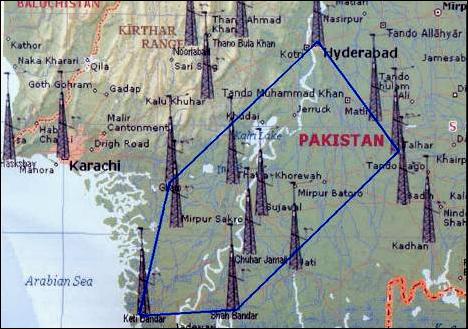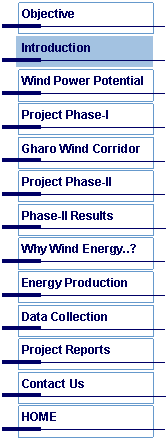





|
Introduction |
|
Wind and Solar energies are the possible clean and low cost renewable resources available in the country. The potential, for the use of alternative technologies, has never been fully explored in Pakistan. Wind power provides opportunity to reduce dependence on imported fossil fuel and at the same time expands the power supply capacity to remote locations where grid expansion is not practical. Recently conducted survey of Wind Power Potential along coastal areas of the country by Pakistan Meteorological Department (PMD), indicates that a potential exists for harvesting wind energy using currently available technologies, especially along Sindh coast. Gharo, one of the sites in Sindh where the wind data have been recorded and studied by PMD, has been selected for Using the measured wind data the annual gross energy production by an 18 MW wind farm consisting of thirty – 600 kW turbines will be 45 million kWh. Taking into account the wind turbine availability, net losses and wake effects in the wind farm the net annual energy production is estimated to 31 million kWh per year corresponding to a capacity factor of 28%. The total investment will be Rs: 850 million and pay back period will be 7-8 years. The capital cost of wind power projects ranges Rs 4 to 5 crore per MW. This gives a levelised cost of wind energy generation in the range of Rs: 2.50 to 3.00 per kWh, taking into consideration the fiscal benefits extended by the government. Wind Power Production There are two terms to describe basic electricity production. 1. Efficiency, 2. Capacity factor. Efficiency refers to how much useful energy (electricity, in this case) we can get from an energy source. A 100 percent energy efficient machine would change all the energy put into it into useful energy. It would not waste any energy. There is no such thing as a 100 percent energy efficient machine. Some energy is always lost or wasted when one form of energy is converted to another. The lost energy is usually in the form of heat, which dissipates into the air and cannot be used again economically. How efficient are wind machines? Wind machines are just as efficient as most other plants, such as coal plants. Wind machines convert 30-40 percent of the wind’s kinetic energy into electricity. A coal-fired power plant converts about 30-35 percent of the chemical energy in coal into usable electricity. Capacity refers to the capability of a power plant to produce electricity. A power plant with a 100 percent capacity rating would run all day, every day at full power. There would be no down time for repairs or refueling, an impossible goal for any plant. Coal plants typically have a 75 percent capacity rating since they can run day or night, during any season of the year. Wind power plants are different from power plants that burn fuel. Wind plants depend on the availability of wind, as well as the speed of the wind. Therefore, wind machines cannot operate 24 hours a day, 365 days a year. A wind turbine at a typical wind farm operates 65-80 percent of the time, but usually at less than full capacity, because the wind speed is not at optimum levels. Therefore, its capacity factor is 30-35 percent. Economics also plays a large part in the capacity of wind machines. Winds machines can be built that have much higher capacity factors, but it is not economical to do so. The decision is based on electricity output per dollar of investment. Capacity Factor The annual energy output from a wind turbine is to look at the capacity factor for the turbine in its particular location. By capacity factor we mean its actual annual energy output divided by the theoretical maximum output, if the machine were running at its rated (maximum) power during all of the 8766 hours of the year. Example: If a 600 kW turbine produces 1.5 million kWh in a year its capacity factor is = 1500000: (365.25 * 24 * 600) = 1500000: 5259600 = 0.285 = 28.5 per cent. Capacity factors may theoretically vary from 0 to 100 per cent, but in practice they will usually range from 20 to 70 per cent, and mostly be around 25-30 per cent. |

|
Copyright © 2008 Pakistan Meteorological Department. All Rights Reserved. |
|
Pakistan Meteorological Department WIND ENERGY PROJECT A Project funded by Ministry of Science & Technology |
|
Wind Energy is clean & renewable source of energy and is also the world’s fastest growing energy resource. Pakistan Meteorological Department (PMD) with the financial collaboration of Ministry of Science & Technology (MoST), has completed its project entitled “Wind Power Potential Survey of Coastal Areas of Pakistan (Phase-I)” in June 2005. Phase-II consisting of Wind Mapping of Northern Areas of Pakistan is own going since July 2005. The demand for energy has increased in tremendous proportions in the last few decades in Pakistan; the same is expected to increase further in the coming years. The primary sources of energy available in Pakistan are oil, natural gas, hydro and nuclear Power. At present oil accounts for approximately 45% of total commercial energy supply. The share of natural gas is 34% while that of hydel power remains roughly at 15%. The increase in cost of fossil fuel and the various environmental problems of large scale power generation have lead to increased appreciation of the potential of electricity generation from non-conventional sources. This has provided the planners and economists to find out other low cost energy resources. |